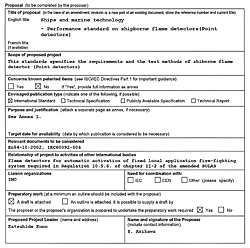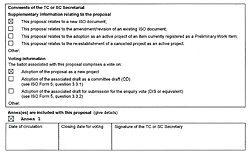|
添付資料 11
| NEW WORK ITEM PROPOSAL |
Date of presentation: 2002-11-03
Proposer: JISC/JMSA
Secretariat: ANSI
Reference number(to be given by the Secretariat): ISO/TC8/SI1 N |
|
A proposal for a new work item within the scope of an existing committee shall be submitted to the secretariat of that committee with a copy to the Central Secretariat and, in the case of a subcommittee, a copy to the secretariat of the parent technical committee. Proposals not within the scope of an existing committee shall be submitted to the secretariat of the ISO Technical Management Board.
The proposer of a new work item may be a member body of ISO, the secretariat itself, another technical committee or subcommittee, or organization in liaison, the Technical Management Board or one of the advisory groups, or the Secretary-General.
The proposal will be circulated to the P-members of the technical committee or subcommittee for voting, and to the 0-members for information.
See overleaf for guidance on when to use this form.
IMPORTANT NOTE: Proposals without adequate justification risk rejection or referral to originator.
Guidelines for proposing and justifying a new work item are given overleaf.
| (拡大画面:148KB) |
 |
| (拡大画面:38KB) |
 |
Use this form to propose:
a) a new ISO document (including a new part to an existing document), or the amendment/revision of an existing ISO document;
b) the establishment as an active project of a preliminary work item, or the re-establishment of a cancelled project;
c) the change in the type of an existing document, e.g. conversion of a Technical Specification into an International Standard.
This form is not intended for use to propose an action following a systematic review - use ISO Form 21 for that purpose.
Proposals for correction (i.e. proposals for a Technical Corrigendum) should be submitted in writing directly to the secretariat concerned.
Guidelines on the completion of a proposal for a new work item
a) Title: Indicate the subject of the proposed new work item.
b) Scope: Give a clear indication of the coverage of the proposed new work item. Indicate, for example, if this is a proposal for a new document, or a proposed change (amendment/revision). It is often helpful to indicate what is not covered (exclusions).
c) Envisaged publication type: Details of the types of ISO deliverable available are given in the ISO/IEC Directives, Part 1 and/or the associated ISO Supplement.
d) Purpose and justification: Give details based on a critical study of the following elements wherever practicable. Wherever possible reference should be made to information contained in the related TC Business Plan.
1) The specific aims and reason for the standardization activity, with particular emphasis on the aspects of standardization to be covered, the problems it is expected to solve or the difficulties it is intended to overcome.
2) The main interests that might benefit from or be affected by the activity, such as industry, consumers, trade, governments, distributors.
3) Feasibility of the activity: Are there factors that could hinder the successful establishment or general application of the standard?
4) Timeliness of the standard to be produced: Is the technology reasonably stabilized? If not, how much time is likely to be available before advances in technology may render the proposed standard outdated? Is the proposed standard required as a basis for the future development of the technology in question?
5) Urgency of the activity, considering the needs of other fields or organizations. Indicate target date and, when a series of standards is proposed, suggest priorities.
6) The benefits to be gained by the implementation of the proposed standard; alternatively, the loss or disadvantage(s) if no standard is established within a reasonable time. Data such as product volume or value of trade should be included and quantified.
7) If the standardization activity is, or is likely to be, the subject of regulations or to require the harmonization of existing regulations, this should be indicated.
If a series of new work items is proposed having a common purpose and justification, a common proposal may be drafted including all elements to be clarified and enumerating the titles and scopes of each individual item.
e) Relevant documents: List any known relevant documents (such as standards and regulations), regardless of their source. When the proposer considers that an existing well-established document may be acceptable as a standard (with or without amendment), indicate this with appropriate justification and attach a copy to the proposal.
f) Cooperation and liaison: List relevant organizations or bodies with which cooperation and liaison should exist.
ANNEX 1
Amendments to chapter II-2 of SOLAS 74 was adopted at MSC 73 by resolution MSC.99(73) as set out in ANNEX 7 to MSC 73/21/Add.2. According to regulation 10.5.6.2 of chapter II-2 of the above amended SOLAS, category A machinery spaces above 500m3 in volume shall, in addition to the fixed fire-extinguishing system required in regulation 5.1.1 of chapter II-2 of the above amended SOLAS, be protected by fixed water-based or equivalent local application fire-fighting system. Furthermore, in the case of periodically unattended machinery spaces, fixed local application fire-fighting systems shall have both automatic and manual activation capabilities at high fire risk areas as described in regulation 10.5.6.3 of chapter II-2 of SOLAS, as amended.
In order to activate the fixed local application fire-fighting systems promptly and correctly to the area of fire, accurate, quick detection and identification of such a local fire is essential. Smoke detectors and heat detectors have been used widely today in machinery spaces. However, air currents can often interfere with the effective operation of such types of detectors making it difficult to identify the specific location of a local fire. In general, large air currents are continuously present in the machinery space to supply adequate air for safe operation of machinery and the safety of personnel activity in the machinery space.
From such a point of view, flame detectors are a more effective means of detecting local fires rather than smoke detectors and heat detectors in the machinery space because flame detectors are able to detect and identify fire regardless any air currents.
With respect to standards for flame detectors, it is recognized that a European standard for flame detectors is being developed (EN 54-10) for use in fire detection systems in buildings. We think, therefore, that international guidelines for the approval of flame detectors need to be established because no worldwide standard, such as ISO, exists for marine use, at present.
Accordingly, we propose to develop an international standard for flame detectors used in marine environmental conditions having due regard to the draft European standard and possible additional requirements for marine environmental conditions. It was noted that this proposal was introduced at IMO FP46, held on February 2002, where it was also noted to propose a draft standard to ISO/TC8/SC1.
The End
|